Iran in the 1950s
The newspapers and periodicals from this period allow us to witness and gain contemporary insights into developments during a momentous period in modern Iranian history. The rise to power of nationalist Prime Minister Mohammad Mossadegh led to the nationalisation of the oil industry in 1951, which had been controlled by the British since 1908. The period following this saw intense societal participation in politics, such as the July 1952 Uprising in support of Mossadegh and his government’s nationalisation programme through to his ousting in the August 1953 coup.
From the British perspective, Iranian oil had become crucial during World War II and was the primary reason for the joint Anglo-Soviet invasion of Iran in 1941. As the Cold War commenced in Northern Iran in 1945-46, in a dispute which also hinged upon Soviet attempts to secure an oil concession in Iranian territory bordering the USSR, Britain sought to exert full control over Iran’s energy resources and reap the wealth it brought through the Anglo Iranian Oil Company.
The Mossadegh period also witnessed the heyday of the Tudeh Party, a pro-Moscow political organisation which was founded in the immediate aftermath of the Soviet invasion of 1941. Over time, the Tudeh's rise in popularity and influence was seized upon by the British government to persuade the Truman and Eisenhower administrations in Washington that Mossadegh was little more than a figurehead pushing Iran towards the Eastern bloc.
The Tudeh Party itself competed for political influence within Iranian society among a broad range of opposition groups. Part of this rivalry was played out in the nation’s press, with each opposition group publishing their own raucous and informative newspapers, weeklies and monthlies. The lack of strict government censorship during this period meant that a lively and strident press thrived up until the 19th August 1953 coup, when the coup’s orchestrators closed down the newspapers as part of their takeover of power.
Irān-i Bāstān
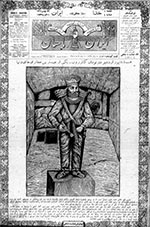 Literally "Ancient Iran", this periodical was edited in the current first series between 1933 and 1935 by Abdulrahman Saif Azad, a German sympathiser. It sought to engage with contemporary affairs through constant reference to the 'glorious' ancient past of Iran and occasionally to the symbols and representations of early Nazi Germany, and particularly what were perceived to be its achievement in science and technology, which Saif Azad witnessed directly in his travels to Germany.
Literally "Ancient Iran", this periodical was edited in the current first series between 1933 and 1935 by Abdulrahman Saif Azad, a German sympathiser. It sought to engage with contemporary affairs through constant reference to the 'glorious' ancient past of Iran and occasionally to the symbols and representations of early Nazi Germany, and particularly what were perceived to be its achievement in science and technology, which Saif Azad witnessed directly in his travels to Germany.
Khāk va khūn
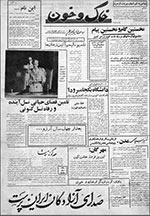 Literally, "Dust and Blood", Khāk va khūn was the weekly of the Pan-Iranist Party, a radical nationalist and chauvinistic movement which emerged in the 1940s and has operated intermittently until the present day. The Pan-Iranist Party emphasised the unity of the 'Persian' nation beyond the borders of Iran, Afghanistan and Iraq.
Literally, "Dust and Blood", Khāk va khūn was the weekly of the Pan-Iranist Party, a radical nationalist and chauvinistic movement which emerged in the 1940s and has operated intermittently until the present day. The Pan-Iranist Party emphasised the unity of the 'Persian' nation beyond the borders of Iran, Afghanistan and Iraq.
This collection, which marks the first year of publication of Khāk va khūn, is mainly centred on the party’s main preoccupation of the time: the attempts to incorporate Iraqi Kurdistan as part of the greater Iranian nation. Approximately 150 issues were published during this year.
Mardum-i Irān
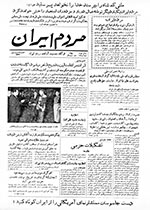 The official organ of an early religious-socialist group, the Khodāparastān-e Sosialist (literally, "God-Worshipping Socialists"), Mardum-i Irān was a weekly which was part of the radical fringe of publications supporting Dr Mohammad Mossadegh during 1951-53. It reflects the early attempts to operate a syncretic fusion between egalitarian strands of Shiism and socialism.
The official organ of an early religious-socialist group, the Khodāparastān-e Sosialist (literally, "God-Worshipping Socialists"), Mardum-i Irān was a weekly which was part of the radical fringe of publications supporting Dr Mohammad Mossadegh during 1951-53. It reflects the early attempts to operate a syncretic fusion between egalitarian strands of Shiism and socialism.
The last issue of Mardum-i Irān was published on 17 August 1953, two days before the overthrow of Mossadegh, and was dedicated to pressing for the establishment of a Republic in the aftermath of the departure of the Shah from the country.
Nabard-i Zindagī and ʻIlm va Zindagī
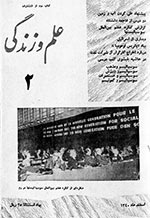 Literally "The Struggle of Life" and "Science and Life", Nabard-i Zindagī and ʻIlm va Zindagī were published under the aegis of Khalil Maleki, a major theoretician of the Iranian left who broke ranks from the pro-Moscow Tudeh Party in the late 1940s and founded the Third Force party, one of the main allies of former Prime Minister Mohammad Mossadegh prior to the coup of August 1953.
Literally "The Struggle of Life" and "Science and Life", Nabard-i Zindagī and ʻIlm va Zindagī were published under the aegis of Khalil Maleki, a major theoretician of the Iranian left who broke ranks from the pro-Moscow Tudeh Party in the late 1940s and founded the Third Force party, one of the main allies of former Prime Minister Mohammad Mossadegh prior to the coup of August 1953.
These two publications were initiated in 1957 as a way to rekindle Third Force activities following years of repression and incarceration in the wake of the Shah’s return to power in 1953. The publications combine theoretical articles on philosophy and history with incisive analyses of the current state of Iranian politics and society. Publications were suspended around 1960 as state repression once again took hold.
Nīrū-yi sivvum
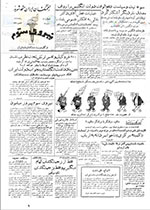 Nīrū-yi sivvum (Third Force), presented here in its entirety, was the official daily newspaper of the Third Force, a prominent member of the pro-Mossadegh alliance between 1951 and 53.
Nīrū-yi sivvum (Third Force), presented here in its entirety, was the official daily newspaper of the Third Force, a prominent member of the pro-Mossadegh alliance between 1951 and 53.
It was one of the strongest pro-Mossadegh parties and was active up until the day of the August 1953 coup against Mossadegh.
This daily provides exceptional insight into the activities of the Third Force and enables close analysis of the circumstances which led to the coup.
Shūrish
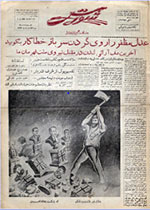 Shūrish (Rebellion) was a strong press supporter of Prime Minister Mohammad Mossadegh (1951-53).
Shūrish (Rebellion) was a strong press supporter of Prime Minister Mohammad Mossadegh (1951-53).
It was published for a total of 88 issues, most of which were destroyed in the period following the August 1953 coup. It's editor, Karimpur Shirazi, was burnt to death by the security forces in the autumn of 1953.
Shūrish followed an uncompromisingly strident and radical line towards the opponents of Mossadegh, and supported the prime minister from a position of radical progressive nationalism.
Tihrān-i muṣavvar
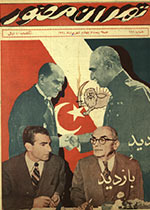 Tihrān-i muṣavvar (Tehran Illustrated) was a popular weekly news magazine which had an occasional focus on pictorial, rather than text content.
Tihrān-i muṣavvar (Tehran Illustrated) was a popular weekly news magazine which had an occasional focus on pictorial, rather than text content.
It was published from the 1940s until August 1979. The Nashriyah project has already digitised the 1979 collection and now presents the Mossadegh era. During this period Tihrān-i muṣavvar was often the informal and unofficial outlet of army military intelligence, and as such has considerable value for the scholars of that period.
